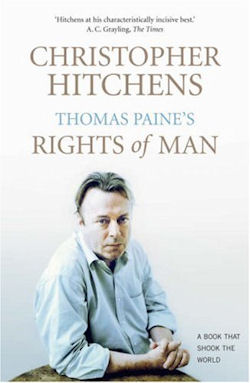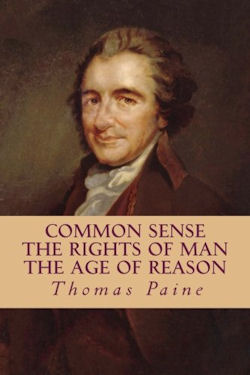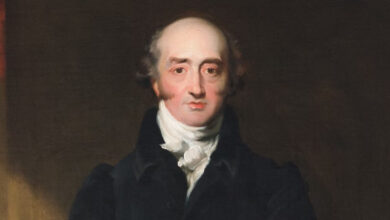“The harder the conflict, the more glorious the triumph” – Thomas Paine
Podcast: Play in new window | Download
Subscribe: Spotify | Amazon Music | Youtube Music | RSS
Thomas Paine Biography
Thomas Paine was born on 9 February 1737, in Thetford, Norfolk, England. He was the son of a Quaker father called Joseph and an Anglican mother called Frances. He attended Thetford Grammar School between the ages of 7 and 13 after which he was apprenticed to his father who was a stay-maker. Stay being a word no longer used for what is now called a corset.
In around 1756 when he was about 20 years old, Thomas moved to London and would never return to Thetford. However, he did return to his father’s trade when in 1759 he opened a shop at 20 New Street in Sandwich, Kent. The building still stands and there is a plaque on the wall above the door identifying it as Tom Paine’s Cottage.
It was in Sandwich where he met a local girl called Mary Lambert and on 27 September 1759, the couple were married at St. Peter’s Church, after which Mary almost immediately became pregnant with their first child. Less than a year later, tragedy struck, when shortly after the couple had moved to Margate, Mary went into early labour. She and the child both died.
Thomas became an excise officer in various locations at the whim of the Board of Excise. He was appointed to Lewes in Sussex in 1768 where he lived above Bull House, within which he established a tobacco shop. During this time Thomas started to take an interest in politics and he became a member of the Court Leet, which governed the town. He also met his second wife during this time, Elizabeth Ollive, and they were married on 26 March 1771.
In 1772, and in an effort to seek better pay and working conditions from parliament, Paine wrote his first pamphlet, entitled “The Case of the Officers of Excise”, 4000 copies of which were distributed to the members of the house as well as other influential people in London.
Two years later, he was dismissed from the excise service for being absent without permission. More bad luck would follow later that year as his tobacco shop business also failed and he formally separated from his wife.
By September of 1774, Paine had moved to London and was introduced to Benjamin Franklin, by Commissioner of the Excise, George Lewis Scott. During a conversation with Paine, Franklin recommended that he move to the British Colonies in America, and provided Paine with a letter of recommendation to help him do so. By 30 November Thomas found himself in Philadelphia ready to start the next chapter of his life.
Thomas became a citizen of Pennsylvania and became editor of the Pennsylvania Magazine, a role which he seemed to take to like a duck to water. Two years after his arrival in America, he produced one of his most famous pieces of work, entitled Common Sense, which popularised ideas for an independent American republic that were previously only discussed in privileged circles. During the course of the American Revolutionary War, which was already underway, over half a million copies of Common Sense were sold.
Thomas Paine followed up Common Sense with a series of pamphlets called The American Crisis. George Washington had the pamphlet read aloud to his troops in order to inspire them during their battles with the British. In a later pamphlet, it was Paine who coined the term, United States of America.
In 1777 Paine joined the Congressional Committee on Foreign Affairs as its secretary. He resigned from the post due to certain indiscretions but that didn’t stop him from receiving an estate in New Rochelle, New York as thanks for services. He also received money from the state of Pennsylvania and from Congress.
In 1787, Paine travelled back to England in the unofficial capacity as American Ambassador. He met Thomas Jefferson whilst in London and became interested in the French Revolution. He produced his next great work, entitled Rights of Man, again on the theme of revolutionary change. It was published in 1791 and sold over a million copies. Paine immediately followed this up with Rights of Man, Part the Second, Combining Principle and Practice in February 1792. The French lapped it up and Paine along with Alexander Hamilton, George Washington and Thomas Jefferson were made honourary French citizens. However, Paine argued against the execution of the King and fell into disfavour with those now in power, in particular, French politician Maximilien Robespierre. Paine ended up being arrested and imprisoned. Arguments were made for Paine’s release but to no avail and he was marked for execution. His luck held though as the gaoler placed the chalk mark identifying those prisoners to be executed on the inside of Paine’s cell door, which was open because he had been receiving visitors, rather than the outside, so when the executioners came to call, he simply closed the door and they didn’t see the mark.
During his time in prison, Paine formulated his final great work, which was published as a series of pamphlets in 1794, 1795 and 1807. The Age of Reason was an argument against faith and in favour of reason, stating that the bible was a piece of literature written by men rather than a divine text and it highlighted what Paine saw as corruption in the Christian church. The Age of Reason was a huge hit in the United States but was met with a somewhat cooler reaction in England and France.
In around 1802, Paine left France and returned to America but he ran into political trouble due to the thoughts he had expressed in The Age of Reason and because of an earlier attack he had launched on George Washington whom he believed had conspired with Robespierre to have him imprisoned. His right to vote in New Rochelle was revoked as Governor Morris did not recognise his American citizenship.
Thomas Paine died on 8 June 1809 in Greenwich Village, New York City. He was 72 years old. His last will decreed that his body should be buried in the Quaker graveyard at New Rochelle, but the Quaker community would not allow it, so he was buried instead under a walnut tree on his farm.
In 1819, an English journalist called William Cobbett arranged for Thomas Paine’s bones to be dug up and transported back to England with the intention of reburying them there. However, the re-burial never happened and Paine’s bones were still in Cobbett’s possession when he died over twenty years later. They have since been lost to history with no sound evidence of where they might reside.
Podcast: Play in new window | Download
Subscribe: Spotify | Amazon Music | Youtube Music | RSS
Thomas Paine: Further Reading
If this short biography has inspired you to find out more about the works of Thomas Paine, then a good starting point may be Thomas Paine’s Rights of Man by Christopher Hitchens.
Thomas Paine is one of the greatest political advocates in history. Declaration of the Rights of Man, first published in 1791, is the key to his reputation. Inspired by his outrage at Edmund Burke’s attack on the uprising of the French people, Paine’s text is a passionate defence of man’s inalienable rights. In Rights of Man Paine argues against monarchy and outlines the elements of a successful republic, including public education, pensions and relief of the poor and unemployed, all financed by income tax. Since its publication, Rights of Man has been celebrated, criticised, maligned and suppressed but here the polemicist and commentator Christopher Hitchens marvels at its forethought and revels in its contentiousness. Above all, Hitchens demonstrates how Thomas Paine’s book forms the philosophical cornerstone of the first democratic republic, whose revolution is the only example that still speaks to us: the United States of America.
Or why not consider reading the work itself. All three of the most significant pieces of work by Thomas Paine, Common Sense, The Rights of Man and The Age of Reason are available here, unabridged, in a single place.






